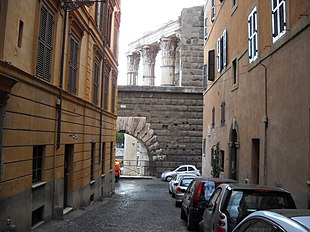 Via Baccina with the Wall of Suburra, Arco dei Pantani and the Temple of Mars Ultor | |
| Alternative name | Subura |
|---|---|
| Location | Rome, Italy |
| Type | Urban neighborhood |
| History | |
| Cultures | Ancient Rome |
The Suburra, or Subura (from the latin Subura) was a vast and populous neighborhood of Ancient Rome, located below the Murus Terreus on the Carinae[1] and stretching on the slopes of the Quirinal and Viminal hills up to the offshoots of the Esquiline (Oppian, Cispian and Fagutal hills[2]).
Since the lower part of the neighbourhood – although overlooking an area of monuments and public services – was home to an urban underclass who lived in miserable conditions, as well as a pleasure district,[3] the term suburra has remained in the Italian language with the generic meaning of 'disreputable place", "place of ill repute" or similar.
Julius Caesar lived in a family home (domus) in the Suburra until, in 63 BC, he was elected pontifex maximus at the age of 37. The Suburra had grown up around the property many years before his birth. The poet Martial also lived there.
- ^ Varro De Lingua Latina 5.48
- ^ L. Richardson, jr (1 October 1992). A New Topographical Dictionary of Ancient Rome. JHU Press. pp. 373–. ISBN 978-0-8018-4300-6.
- ^ Hales, S., E. Smith, E. Keogh (2 December 2020). "Places: 451696383 (Subura)". Pleiades. Retrieved 2 December 2020.
{{cite web}}: CS1 maint: multiple names: authors list (link)